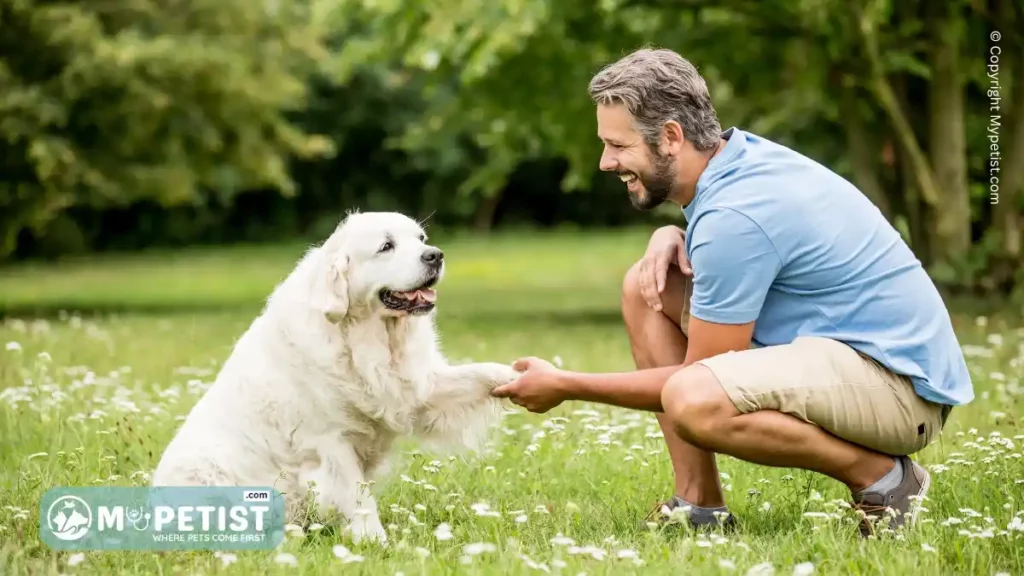Dogs are known for their loyalty, companionship and protective instincts. However, excessive barking can be a source of annoyance for both the dog owner and their neighbors. There are several methods to stop dog barking behavior, including positive reinforcement, desensitizing techniques and the use of anti-bark collars.
If your dog is barking excessively, it can be a sign of stress, anxiety or boredom. It is important to address this behavior as soon as possible to avoid any potential legal issues or neighborhood disputes. In this article, we will explore some of the most effective ways to train your dog to stop barking and promote peace and tranquility in your home and community.
Reasons Why a Dog Barks
Territorial behavior
Territorial behavior is a common reason why a dog barks. Dogs are inherently territorial animals, and they often see their home and the area around it as their own. If another dog enters this territory, your dog behavior may bark as a way of warning the intruder to stay away.
Dogs who are less likely to bark may still bark when it comes to protecting their territory. Rewarding your dog when they don’t bark can help to reinforce this behavior, making them less likely to bark in the future. However, it is important to note that there are other reasons why a dog may bark. If your dog is barking excessively, it may be a sign of separation anxiety, boredom or other issues that should be addressed. Understanding why your dog is barking is the first step in addressing any unwanted behavior.
Communication as a Reason why a dog barks

Communication is one of the most common reasons why a dog barks. Dogs use barking to communicate with their owners and other animals. For example, when a dog sees another dog, they may bark to signal their presence and try to establish dominance. However, some dogs are less likely to bark than others, depending on the breed and individual dog behavior.
As a pet owner, it is important to reward your dog for appropriate barking behavior and train them to not bark excessively. This can prevent behavioral issues and potential noise complaints. Despite this, it is important to remember that dogs may bark for a variety of reasons that may not necessarily be related to communication, such as boredom, anxiety, or territorial behavior.
Boredom
Boredom can be one of the major reasons why dogs bark excessively. When dogs lack physical and mental stimulation, they tend to get bored easily, leading to unwanted behaviors such as constant barking. It is essential to provide dogs with suitable toys and engaging activities to keep them entertained and mentally stimulated.
Pet Behavioral Problems: How to Identify and Correct Them
Without the proper stimulation, dogs can become restless and anxious, leading to destructive behavior and non-stop barking. Furthermore, dogs may also bark out of boredom as a way to get attention from their owners or to express their frustration. Therefore, it is crucial to devote sufficient time to interact with and exercise your furry friend, preventing them from getting bored, and ultimately mitigating excessive barking.
Fear or anxiety
Fear or anxiety is one of the most common reasons why a dog barks. Dogs may bark when they are frightened or feel threatened, especially when they are in a new or unfamiliar environment. They may also bark excessively when left alone for long periods of time because they feel lonely or fearful. Some dogs may bark at strangers or other animals because they are anxious or afraid of them.
In addition, loud noises, such as thunderstorms or fireworks, can trigger fear and anxiety in dogs, causing them to bark excessively. It is important to identify the root cause of a dog’s barking and provide appropriate training, socialization, and support to help them overcome their fears and anxieties. Proper training and socialization can help to reduce a dog’s anxiety and teach them to react appropriately in different situations.
Understanding your dog
Understanding your dog Body language

Understanding your dog’s body language is one of the most essential things you can do as a pet owner. Dogs communicate through body language, and their posture, tail movements, and facial expressions can tell you a lot about how they are feeling. For example, if your dog is wagging their tail in a relaxed and loose manner, it indicates that they are happy and comfortable.
On the other hand, if their tail is tucked between their legs, they are feeling anxious, scared, or uncomfortable. Similarly, if your dog has their ears pinned back against their head, it often shows that they are feeling fearful or aggressive. Observing your dog’s body language is crucial to respond to their emotions and foster a stronger bond between you and your furry friend.
Understanding your dog Vocalizations
Understanding your dog’s vocalizations is an important part of being a responsible pet owner. Dogs communicate through a variety of vocal cues, including barks, whines, growls, and howls. These sounds convey different emotions or messages, such as warning of danger, expressing excitement, or indicating fear. As a pet owner, it’s important to learn the specific vocalizations your dog uses and what they mean in different contexts.
How to Stop A Dog From Jumping On People
For example, a high-pitched yelp may indicate pain or discomfort, while a low growl might signal aggression. Additionally, dogs may use different tones or frequencies to communicate different emotions, such as a playful bark versus a defensive bark. Understanding your dog’s vocalizations can help strengthen the bond between you and your pet, as well as ensure their safety and wellbeing.
Understanding your dog Triggers
Understanding your dog’s triggers is an important aspect of being a responsible pet owner. A trigger is something that sets off a behavioral or emotional reaction in your dog. Some common triggers could be loud noises, sudden movements, unfamiliar people or animals, and even certain scents or locations. It’s essential to identify your dog’s triggers to prevent any unpleasant or dangerous situations. Once you understand your dog’s triggers, you can work on desensitizing them and training your dog to behave appropriately in those circumstances. This can improve your dog’s overall well-being and strengthen your relationship with them. Remember, taking the time to understand your dog’s behavior can prevent problems down the line and ensure a happy and healthy life together.
Energy level of your dog
Understanding the energy level of your dog is crucial to ensuring their overall wellbeing. Every dog has a unique energy level which is influenced by their breed, age, size, and individual personality. Knowing your pet’s energy level will help you plan their diet, exercise, and daily activities. High energy dogs require more exercise and mental stimulation, whereas low energy dogs require less exercise but still need sufficient playtime to maintain a healthy lifestyle.
Pet parents should also be aware that an inadequate energy outlet can lead to behavioral problems such as chewing, digging, and barking. It is important to observe your dog’s behavior and adjust their routine and activities accordingly. A well-exercised and stimulated pet is a happy and healthy one.
Dog Positive reinforcement training
A. “Quiet” command in Dog Positive reinforcement training
In positive reinforcement dog training, the “quiet” command is essential for controlling unwanted barking behavior. This command aims to stop a dog from barking excessively by teaching them that quiet behavior is rewarded.
To start this training, first get your dog to bark by using a trigger sound or phrase. Use the “quiet” command firmly and consistently when they start barking and reward them with treats or praise when they stop. Over time, reduce the need for treats as your dog learns the association between being quiet and receiving positive feedback.
Best Home Remedies for Acne: Treat Acne at Home
It is important to remember that dogs have different personalities and levels of responsiveness, so patience and consistency are key in their training journey towards mastering the “quiet” command. With practice and repetition, you can help your furry companion become well-behaved while maintaining a peaceful environment at home.
B. Treats or rewards in Dog Positive reinforcement training
Positive reinforcement training is one of the most effective dog training methods available. One aspect of this technique is providing treats or rewards for good behavior. Treats can be used to motivate your dog and reinforce desired behaviors, making them more likely to repeat them in the future.
When choosing treats, it’s important to keep in mind your dog’s individual preferences and any dietary restrictions they may have. Soft, small treats are often the best choice as they are easy to chew and won’t distract your dog for too long. Some popular treat options include chicken jerky, cheese cubes, freeze-dried liver bites, and peanut butter.
It’s important to use treats sparingly so that your dog doesn’t become reliant on them for obedience. Gradually phase out their use once your dog has mastered a particular behavior so that they continue to obey without expecting a reward every time. Remember that positive reinforcement isn’t just about giving treats – verbal praise and physical affection can also be powerful motivators for dogs.
C. Consistency in Dog Positive reinforcement training
Consistency is key when it comes to positive reinforcement training for dogs. Dogs thrive off of routine and predictability, so it’s important to establish consistent rules and expectations during training sessions. This means using the same verbal cues and hand signals for each behavior you want your dog to learn, as well as rewarding them consistently every time they exhibit that behavior.
Inconsistency can lead to confusion for your dog and make it more difficult for them to understand what you are trying to teach them. For example, if you reward your dog one time for sitting but not the next time they sit, they may not understand why they aren’t receiving a reward and become less motivated to continue learning. Additionally, being inconsistent in your commands can lead to frustration on both ends – your dog won’t know what you want from them, and you’ll become frustrated with their inability to perform.
By establishing clear boundaries and consistently rewarding good behavior, you’ll not only see better results in terms of obedience but also build a stronger bond with your furry companion. Training should be an enjoyable experience for both parties involved, so make sure you’re setting yourselves up for success by staying consistent throughout the process.
D. Avoiding punishment in Dog Positive reinforcement training
Positive reinforcement is a training method that rewards dogs for good behavior. It is an effective and humane way of training your dog. However, some people are concerned that positive reinforcement training means avoiding punishment altogether. The truth is, punishment can be a part of positive reinforcement training but it must be done correctly.
One way to avoid punishment in positive reinforcement training is to use redirection instead. For example, if your dog jumps on you or another person, you can redirect their attention by giving them a toy or treat to play with. This will help them learn that jumping up is not the behavior that gets rewarded.
Another way to avoid punishment in positive reinforcement training is to focus on teaching your dog what behaviors are acceptable rather than punishing them for what they do wrong. This means setting clear expectations and boundaries for your dog and rewarding them when they meet those expectations.
What You Need to Know About Power Circular Saws for DIY Projects
Ultimately, avoiding punishment in positive reinforcement training comes down to understanding your dog’s behavior and using techniques that work best for them. By focusing on reward-based methods like redirection and clear boundary setting, you can help your furry friend become a well-behaved canine companion without resorting to harsh punishments or negative feedback.
Dog Exercise and mental stimulation
Regular exercise is essential for maintaining the physical and mental health of dogs. A regular exercise routine ensures that the dog learns, it starts the day with a clear mind and energy to take on the day. Interactive toys also provide mental stimulation and keep the dog engaged during playtime. Dogs should be trained regularly to keep their minds active, and there are many types of training sessions that can suit different breeds of dogs.
Socialization with other dogs and people is also critical for mental stimulation, as it provides an opportunity for the dog to interact with others and practice social skills. By providing regular exercise and mental stimulation, dogs will have better health outcomes and significantly improve their behavior. Overall, exercise and mental stimulation are essential components of a dog’s overall well-being which help to stop dog barking.
Medical Reasons for Dog Barking:
Dog barking is a common behavior, but sometimes it can be a sign of an underlying health condition. Identifying the medical causes of excessive barking is important to ensure that the right treatment is given. This could involve addressing pain from an injury, discomfort from a skin condition, or changes in behavior due to cognitive decline or anxiety.
Some medical conditions that can cause barking include allergies, infections, neurological conditions, and thyroid disorders. A veterinarian should be consulted if a dog’s barking is causing concern, especially if there are other symptoms such as lethargy or loss of appetite. The veterinarian can perform a full medical examination and recommend a therapy plan that may involve medications, exercise or training techniques, and dietary changes. Treating underlying health problems will contribute to a healthier and more comfortable life for your dog, and a peaceful home for you both.
Alternative solutions for Dog Barking:

Barking is a natural behavior for dogs, but excessive barking can become a nuisance for their owners and neighbors. However, there are several effective alternative solutions for controlling to stop dog barking. One option is to use anti-bark collars, which emit a sound, vibration or spray that interrupts the barking behavior. Another alternative is the use of white noise machines, which create a low-level noise that calms a dog’s anxiety and helps to reduce barking.
Additionally, seeking the help of a professional dog trainer or behaviorist is another viable solution to address excessive barking. A certified dog trainer can help identify the root cause of the barking and create personalized training plans to eliminate the problem. Ultimately, dog owners should be aware that there are several alternative solutions available for their furry friends, and with patience and consistency, they can train their dogs to behave more calmly and quietly.
Conclusion
In short, it can be difficult to stop dog barking, especially if they are doing it out of boredom or anxiety. However, by utilizing the strategies discussed in this article, such as offering rewards for desired behavior and avoiding punishment, owners can redirect their pup’s barking into more desirable behaviors.
On top of that, engaging your pup in regular exercise and activities is an important aspect of addressing habitually vocal behavior. Taking all these steps will help create a calmer environment for both you and your pet.